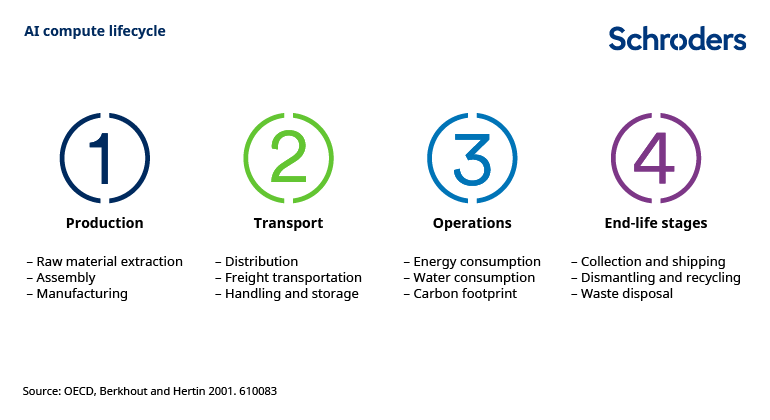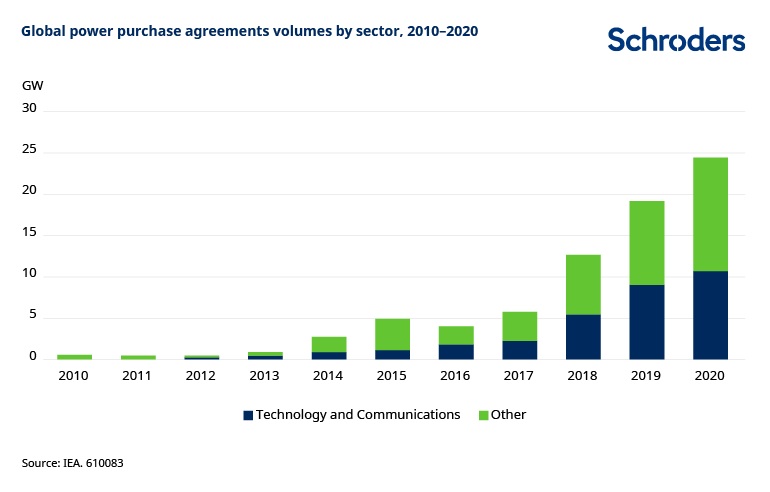We consider the carbon footprint of AI, both in terms of its physical infrastructure and its potential applications.
Artificial intelligence (AI) is rapidly transforming the way we live and work. While AI has the potential to revolutionise many industries, there are significant environmental implications to consider.
Here we focus on the direct environmental effects of AI, and potential solutions to mitigate these. We also look at some of the indirect environmental influences that AI applications may have.
What’s the environmental impact of AI physical infrastructure?
The direct environmental impact of AI is primarily related to the physical infrastructure it requires. This includes datacentres, processors and other specialised computing hardware and is called the AI compute infrastructure. The vast majority of evidence finds the direct environmental impact of AI compute to be largely negative.
The AI compute lifecycle is split into four stages: i) production, ii) transport, iii) operations and iv) end-life stages. The most significant emissions (around 70-80%) come from the operational stage.

1.Production stage
The production stage accounts for the physical extraction of the raw materials and the creation of the component parts required to build the AI hardware and infrastructure. One challenge of measuring this stage is that the resources used typically relate to overall information and communication technology (ICT), rather than specifically AI.
Estimates of the carbon footprint of the AI production stage vary and it is currently seen as relatively insignificant. However, as renewable electricity becomes an increasingly larger part of the energy consumed in the operational stage, the impact of the environmental footprint during the production stage will become more significant.
2. Transport stage
ICT hardware transport accounts for only a small fraction of global transport greenhouse gas emissions, with an even smaller proportion relating to AI compute hardware.
3. Operations stage
This is the primary area of focus when analysing the direct environmental impact of AI. The two main environmental considerations of this stage are energy consumption and water usage.
Energy
We can use data centres as a proxy to contextualise how much energy AI consumes. While not all data centres are used for AI, increasingly AI models are trained, housed and deployed on extremely large, warehouse-scale datacentres. It’s estimated that around 1-1.5% of total electricity demand globally comes from datacentres, equating to c.220-320 terawatt hours.
Amazingly, that is a figure that has remained relatively constant over the past decade despite the substantial increase in datacentre workload. Key reasons for this impressive decoupling have been: i) compute efficiency improvements; ii) the shift to cloud; and iii) the shift towards larger hyperscale datacentres.
Looking at the energy consumption of generative AI more specifically, a study by Harvard found that training Chat GPT-3 took 1.3 gigawatt hours, or about as much electricity as 120 US homes use in a year. The main concern with generative AI is that the model complexity is increasing exponentially, and therefore needs significantly more energy.
With the big tech companies and datacentre operators requiring so much energy, many of them have made significant commitments to renewable energy. This has both pros and cons. The clear negative is that a vast amount of renewable power is being consumed by a single sector.


It can be argued that datacentre operators/owners are supporting renewable energy generation by agreeing to purchase a certain amount of energy from the project developer. But the question is whether the renewable project would have occurred without the tech companies’ financial underwriting, or whether they are contracting from already committed projects.
Water
The water footprint of datacentres is driven by both the water consumed for the electricity generation and the water consumed for cooling.
A recent study by the University of Massachusetts Amherst found that training a single generative AI model can consume as much as 284,000 litres of water. That’s equivalent to the amount of water an average person would consume over the course of 27 years.
This is a significant problem because the use of AI is becoming increasingly widespread across a range of industries. The demand for datacentres and the associated water consumption is only going to increase.
4. End-of-life stage
The primary environmental impact of the AI end-life stage is its contribution to electronic waste. The disposal of AI tech will have significant environmental impacts due to the presence of hazardous materials (such as heavy metals and toxic chemicals), that can leach into the environment and cause pollution.
The implementation of a circular economy model, which involves minimising waste and maximising the use of resources, is crucial to managing the environmental impact of AI.
How can the environmental damage of AI be reduced?
There are four key ways in which data centres and AI are reducing their operational environmental footprint:
- Renewables – the obvious place to start is by using renewable energy to power the datacentres, which the industry is already doing.
- Improve model efficiency – by using, and fine tuning, pre-trained models, AI teams save time and significant amounts of energy when building out models.
- Energy efficient practices – one way datacentres improve efficiencies is through server virtualisation – the process of allowing multiple virtual servers to run on a single physical server. This consolidates servers and hardware resources, reducing the amount of power required to run and cool them.
- Cooling systems – the electrical energy going into a datacentre must eventually be rejected as waste heat through a cooling system. Datacentre cooling accounts for 33-40% of overall datacentre energy usage and consumes hundreds of billions of litres of fresh water per year. Recently there have been significant advances in datacentre cooling technologies that have improved efficiency and reduced costs. The location of the datacentres itself can make a huge difference too. By building datacentres in locations with abundant renewable power and/or cooler climates, significant emissions savings can be made.
Are there any positive environmental impacts of AI?
On the positive side, various innovative methods exist for repurposing the heat generated by datacentres.
Among these is using the excess warmth to bolster district heating systems, whereby high temperature water can be channelled into households and buildings.
Alternatively, this thermal energy may be harnessed for agricultural applications, such as providing year-round heating for greenhouses, or for heating water in fish farms and public swimming pools.
What about the environmental impact of AI applications?
There is almost an infinite number of real world problems which AI can help solve.
Just taking sustainable land use as an example, AI applications include: early crop yield prediction; precision agriculture & nutrition; hyper-local weather forecasting for crop management; early detection of crop problems; automated and enhanced land-use change detection for avoided deforestation; monitoring health and wellbeing in livestock.
Other examples abound, and it is clear that AI has the potential to deliver significant environmental benefits.
However, any AI application that enhances the efficiency of already damaging industries would be considered harmful.
And the argument that AI improves efficiency of operations and therefore is environmentally beneficial only holds true if, for a given task, the energy consumption declines. But as technologies become more efficient and productive, they can lead to increased demand and consumption. This can offset any environmental or economic benefits of the increased efficiency.
—
Originally Posted September 25, 2023 – AI revolution: what’s the environmental impact?
Disclosure: Schroders
Important Information: This communication is marketing material. The views and opinions contained herein are those of the author(s) on this page, and may not necessarily represent views expressed or reflected in other Schroders communications, strategies or funds. This material is intended to be for information purposes only and is not intended as promotional material in any respect. The material is not intended as an offer or solicitation for the purchase or sale of any financial instrument. It is not intended to provide and should not be relied on for accounting, legal or tax advice, or investment recommendations. Reliance should not be placed on the views and information in this document when taking individual investment and/or strategic decisions. Past performance is not a reliable indicator of future results. The value of an investment can go down as well as up and is not guaranteed. All investments involve risks including the risk of possible loss of principal. Information herein is believed to be reliable but Schroders does not warrant its completeness or accuracy. Some information quoted was obtained from external sources we consider to be reliable. No responsibility can be accepted for errors of fact obtained from third parties, and this data may change with market conditions. This does not exclude any duty or liability that Schroders has to its customers under any regulatory system. Regions/ sectors shown for illustrative purposes only and should not be viewed as a recommendation to buy/sell. The opinions in this material include some forecasted views. We believe we are basing our expectations and beliefs on reasonable assumptions within the bounds of what we currently know. However, there is no guarantee than any forecasts or opinions will be realized. These views and opinions may change. Schroder Investment Management North America Inc. is a SEC registered adviser and indirect wholly owned subsidiary of Schroders plc providing asset management products and services to clients in the US and Canada. Interactive Brokers and Schroders are not affiliated entities. Further information about Schroders can be found at www.schroders.com/us. Schroder Investment Management North America Inc. 7 Bryant Park, New York, NY, 10018-3706, (212) 641-3800.
Disclosure: Interactive Brokers
Information posted on IBKR Campus that is provided by third-parties does NOT constitute a recommendation that you should contract for the services of that third party. Third-party participants who contribute to IBKR Campus are independent of Interactive Brokers and Interactive Brokers does not make any representations or warranties concerning the services offered, their past or future performance, or the accuracy of the information provided by the third party. Past performance is no guarantee of future results.
This material is from Schroders and is being posted with its permission. The views expressed in this material are solely those of the author and/or Schroders and Interactive Brokers is not endorsing or recommending any investment or trading discussed in the material. This material is not and should not be construed as an offer to buy or sell any security. It should not be construed as research or investment advice or a recommendation to buy, sell or hold any security or commodity. This material does not and is not intended to take into account the particular financial conditions, investment objectives or requirements of individual customers. Before acting on this material, you should consider whether it is suitable for your particular circumstances and, as necessary, seek professional advice.


























Join The Conversation
If you have a general question, it may already be covered in our FAQs. If you have an account-specific question or concern, please reach out to Client Services.